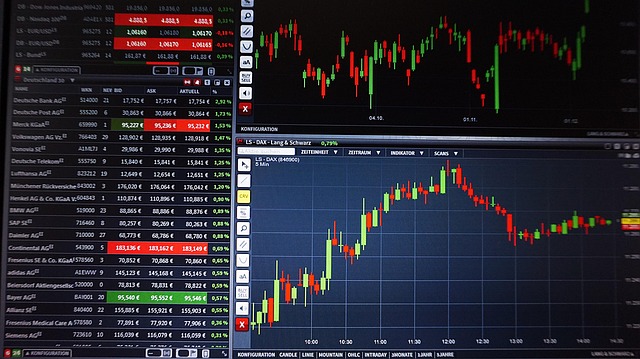Mastering a Demo Share Trading App: Guide to Practice, Strategy, and Risk-Free Learning
Author: Jameson Richman Expert
Published On: 2025-10-24
Prepared by Jameson Richman and our team of experts with over a decade of experience in cryptocurrency and digital asset analysis. Learn more about us.
Demo share trading app platforms let beginners and experienced traders test strategies, learn order types, and practice risk management without risking real capital. This article explains what demo trading apps are, why they matter, how to choose the best one, step-by-step practice routines, advanced examples, and actionable checklists to move from a simulated account to profitable live trading.

What is a demo share trading app?
A demo share trading app (also called a practice or paper trading app) is a simulated trading environment that mirrors a real brokerage’s interface, market data, and order execution — but uses virtual funds. Users place buy and sell orders, set stop losses and take profits, and experiment with technical indicators and strategies in real-time or historical market replay modes. The goal is practical learning without financial risk.
According to Investopedia, paper trading is an educational tool that simulates market conditions and order execution to allow traders to refine strategies before committing real money (see Investopedia’s paper trading entry).
Why use a demo share trading app? Key benefits
- Risk-free learning: Make mistakes and learn from them without losing capital.
- Platform familiarity: Master order types (market, limit, stop) and platform navigation.
- Strategy validation: Test and optimize trading ideas using historical and live data.
- Psychology training: Practice decision discipline and emotional control in simulated stress scenarios.
- Risk management development: Experiment with position sizing, risk/reward ratios, and stop placement in a measurable way.
Core features a quality demo share trading app should offer
When choosing a demo app, prioritize tools that closely replicate live trading conditions so your transition to a funded account is seamless. Look for:
- Real-time market data: Delayed feeds do not replicate true execution. Real-time quotes and depth-of-market (Level II) data are preferable.
- Multiple order types: Market, limit, stop-loss, stop-limit, OCO (one cancels the other), trailing stops.
- Charting and indicators: Built-in technical indicators (moving averages, RSI, MACD, Bollinger Bands), drawing tools, and custom indicators.
- Order execution simulation: Slippage modeling, partial fills, and latency simulation to approximate real-life outcomes.
- Backtesting and replay: Strategy backtesting and market replay to refine setups.
- Account settings: Adjustable starting balance, leverage options, and commission models matching live accounts.
- Mobile and desktop parity: Same user experience across devices so skills transfer smoothly.

Popular demo share trading app types
- Broker-integrated demos: Many brokers provide built-in demo accounts that mirror their live platform. These are ideal for platform-specific practice.
- Standalone simulators: Independent apps focusing on education and backtesting with rich analytics.
- Exchange-specific paper accounts: Crypto and derivatives exchanges often provide testnets or simulated accounts for derivatives and futures trading (useful for traders also testing crypto strategies).
To learn whether a major exchange offers a demo/practice option, see the article on whether Binance provides a demo account: Does Binance have a demo account?
How to choose the best demo share trading app — checklist
Use this checklist to evaluate demo platforms:
- Does the app use real-time or delayed market data?
- Are order types and execution behavior representative of a live account?
- Can you backtest strategies and replay market sessions?
- Is there a way to simulate commissions, spreads, slippage, and margin/leverage?
- Does the platform support mobile trading with the same features as desktop?
- Can you practice trading the exact instruments you plan to trade live (shares, ETFs, options)?
- Are there educational resources, alerts, and reporting tools to measure performance?
Step-by-step beginner roadmap to using a demo share trading app
Follow these steps to build consistent skills and a documented track record in a demo environment.
1. Set clear goals and a plan
Decide what you want to learn (order types, intraday scalping, swing trading) and set measurable goals (e.g., "achieve a 3% monthly return with max drawdown under 5% in demo over three months"). Write your trading plan and criteria for entry, exit, and risk management.
2. Configure the demo to mimic your intended live account
Match starting balance, margin/leverage, commission, and slippage assumptions to the live broker you plan to use. If you plan to trade on specific exchanges, use their simulated environments when available. (For derivatives traders, read guides like Bybit’s minimum trade amount explanations to set expectations: Bybit minimum trade amount — futures explained.)
3. Learn to use charts and indicators
Start with a small indicator toolkit: moving averages for trend, RSI for momentum, and volume for confirmation. For volume analysis techniques, see this practical guide on checking volume effectively: How to check volume in trading effectively.
4. Execute micro-trades and track performance
Place small position trades to learn the order workflow. Record each trade in a trading journal with the date, instrument, entry/exit, strategy rationale, outcome, and lessons learned.
5. Backtest and refine strategies
Use historical backtesting and market replay to iterate strategy parameters and spot weaknesses. Only move to larger positions once you have consistent demo performance matching your pre-defined goals.
6. Simulate real-life constraints
Enforce rules in the demo that you will follow in live trading: weekdays only trading hours, limited daily trade count, and strict risk-per-trade limits. This keeps behavioral fidelity high.
7. Gradual transition to live
When demo performance is stable and consistent for a defined period (e.g., 3–6 months), transition to a small live account and scale up as you maintain performance. Use a controlled, documented scaling plan (e.g., increase capital by 25% after each 2 months of positive performance).

Common demo-to-live pitfalls and how to avoid them
- Overconfidence from demo wins: Demo conditions can lack emotional pressure. To mitigate, enforce real-money consequences (e.g., set rules that mimic losing real capital if you break your plan).
- Ignoring slippage and liquidity: Simulators often execute clean fills. Account for slippage in your risk planning and test on low-liquidity instruments to see the difference.
- Inconsistent risk assumptions: Align demo leverage and fees to the live environment to avoid surprise drawdowns.
- Neglecting trading psychology: Practice with accountability partners or paper penalties to replicate emotional responses.
Examples of demo trading routines for different traders
Intraday trader (scalper) routine
- Pre-market 30-minute news scan and gap check.
- Identify 2–3 high-liquidity shares with clear support/resistance.
- Use 1-minute and 5-minute charts, EMA 9/21 for trend, and VWAP for intraday bias.
- Risk 0.1–0.5% of demo capital per trade; use tight stops and 1:1 or 1.5:1 reward-to-risk.
- Close all positions 15 minutes before market close.
Swing trader routine
- Weekly scan for trending sectors using 50- and 200-day moving averages.
- Use daily charts with RSI 14 and MACD to time entries near pullbacks.
- Risk 0.5–2% per position with wider stops and 2:1 reward-to-risk targets.
- Review positions once per day and adjust stops to breakeven when halfway to the target.
Measuring demo performance — metrics that matter
Beyond raw returns, track metrics that reflect durability and risk control:
- Win rate: Percentage of profitable trades.
- Average win / average loss: Measures expectancy.
- Maximum drawdown: Greatest peak-to-trough decline.
- Sharpe ratio: Risk-adjusted return metric.
- Trades per month and holding time: Ensures your activity level matches your plan.

Advanced uses: testing algorithmic strategies and high-frequency concepts
Demo apps with backtesting and API access let traders design algorithmic strategies. Simulate market microstructure effects by modeling order size, queue priority, and slippage. If you plan to trade derivatives or crypto derivatives, carefully review platform-specific constraints (tick sizes, minimum trade amount, and margin requirements). For derivatives-focused research, see this Bybit futures guide: Bybit minimum trade amount explained.
If you also study crypto trading or cross-asset strategies, articles on broader market definitions and outlooks help frame strategy risk. For example, read about what it means to be a crypto trader in the coming years: Crypto trader meaning in 2025 — an in-depth perspective, and long-term asset forecasts like the Bitcoin 2030 outlook to understand macro tail risks: Bitcoin price in 2030 — forecast and analysis.
Practical example: testing a breakout strategy in a demo app
Below is a simple, reproducible walkthrough for testing a breakout strategy using a demo share trading app.
- Choose a universe of 20 high-liquidity stocks (e.g., S&P 500 constituents).
- Set chart period to daily; mark the last 20 days’ range (high/low).
- Entry rule: Buy at a 1–2% breakout above the 20-day high on volume greater than the 20-day average volume (use the volume-checking guide as reference: how to check volume effectively).
- Stop loss: 1 ATR (Average True Range) below the entry price.
- Profit target: 2x ATR or use a trailing stop at 1 ATR.
- Position sizing: Risk 1% of demo capital per trade.
- Track results in a spreadsheet and calculate win rate, average win/loss, and drawdown after 3 months.
Transitioning from demo to live — a 6-step checklist
- Documented evidence: 3–6 months of consistent demo performance meeting your pre-defined goals.
- Psychology test: Simulate pressure by limiting demo capital to a smaller amount equivalent to what you plan to start live with.
- Platform check: Make sure your live broker supports identical order types, fees, and product universe.
- Account funding plan: Start with a predetermined percent of capital and a scaling schedule based on performance.
- Risk controls: Hard-coded max daily loss (e.g., 2% of account), max position size, and routine for emergency stop-outs.
- Ongoing review: Weekly journal review and monthly P&L analysis with the same metrics tracked during demo.

Demo share trading app examples and where to practice
Many brokers and exchanges provide demo or testnet environments. Consider these categories and links when selecting where to practice:
- Mainstream broker demos — Most established brokers offer demo accounts with simulated equities and ETFs. Check the broker’s education pages or support center for demo registration.
- Crypto exchange practice environments — If you cross-trade crypto and equities, practice on exchange testnets and read platform-specific practice guides (e.g., Binance demo coverage: Does Binance have a demo account?).
- Referral and sign-up resources — If you choose to open live accounts after demoing, use official sign-up links for major exchanges and brokers to ensure correct onboarding and potential promotional benefits:
Case study: from demo to funded account — realistic timeline
Here is a hypothetical case study that outlines a disciplined path from demo proficiency to a funded trading account:
Trader: Jane — part-time trader with a full-time job. She trades US large-cap shares and ETFs using swing setups.
Timeline:
- Month 0–1: Platform onboarding and small intraday experiments. Journal initiated.
- Month 2–4: Systematic backtesting of entry/exit rules; paper-tested 100 trades and refined ATR-based stops.
- Month 5–7: Demonstrated monthly returns averaging 2.5% with max drawdown of 4% in demo. Psychologically tested via smaller virtual account to simulate real-money stress.
- Month 8: Funded a small live account (5% of intended full capital) and followed the same rules. Kept positions small and tracked slippage, commissions, and emotional reactions.
- Month 9–12: Gradual scaling following the documented scaling plan after achieving risk-adjusted live performance consistent with demo results.
Legal and regulatory considerations
Demo accounts are educational tools and not regulated trading. Before moving to live trading, read regulatory materials on investor protection and best practices at authoritative sources like the U.S. Securities and Exchange Commission’s investor education hub (Investor.gov) and understand tax treatment of trades via official tax authority resources.

How to maximize learning in a demo share trading app — best practices
- Keep a detailed trading journal: Include screenshots, trade rationale, and mental state for each trade.
- Set KPIs: Define minimum acceptable performance metrics (win rate, profit factor) and only advance if they are met.
- Use slippage and commission modeling: Adjust your demo to reflect likely real-world costs.
- Test across market regimes: Simulate bull, bear, and volatile sideways markets using historical replay or by extending testing periods.
- Peer review: Share your demo results with mentors or trading communities for feedback; the external perspective often spots overlooked flaws.
Learning resources and further reading
For deeper study on trading psychology, position sizing, and technical analysis consider reputable educational resources:
- Investopedia’s trading tutorials and definitions (e.g., paper trading): Investopedia
- Wikipedia’s overview of stock markets for macro context: Stock market — Wikipedia
- SEC/Investing education for regulatory and risk guidance: SEC Investor.gov
- Specific platform or exchange guides for technical details — for example, see cryptocurrency market outlooks and trading guides at CryptoTradeSignals to expand cross-asset perspective:
Final checklist before you start using a demo share trading app
- Define goals and timeframes (3–6 months for competency testing).
- Choose a demo app that closely mirrors your intended live broker.
- Match fees, leverage, and order types in the demo to live expectations.
- Create a journal template and tracking spreadsheet for performance metrics.
- Practice risk management rules until they become automatic behavior.
- Plan a staged transition to a live account with explicit scaling rules.

Conclusion
A robust demo share trading app is one of the most valuable tools for building a consistent trading edge. When chosen and used correctly, a demo account accelerates learning, reduces costly mistakes, and builds the discipline required for live trading success. Follow a structured plan, keep detailed records, model real-world costs, and gradually transition to live trading only after achieving consistent, documented results.
When you’re ready to move from simulated practice to a live platform, consider reputable exchanges and brokers (links to official sign-up pages are above). Always continue learning and maintain disciplined risk management — successful trading is a marathon, not a sprint.